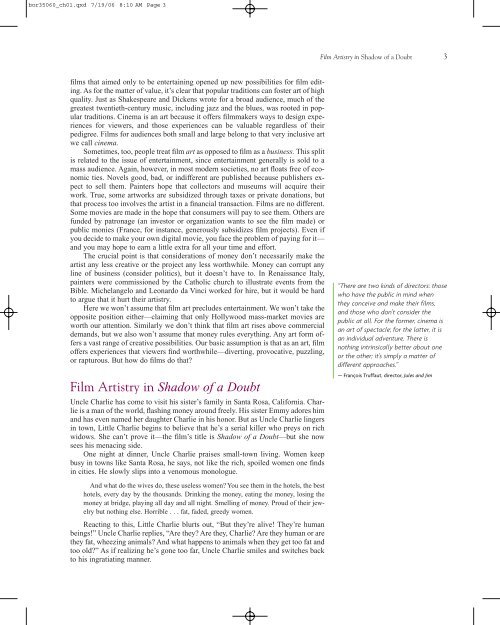FILM ART AND FILMMAKING
FILM ART AND FILMMAKING
FILM ART AND FILMMAKING
You also want an ePaper? Increase the reach of your titles
YUMPU automatically turns print PDFs into web optimized ePapers that Google loves.
or35060_ch01.qxd 7/19/06 8:10 AM Page 3<br />
films that aimed only to be entertaining opened up new possibilities for film editing.<br />
As for the matter of value, it’s clear that popular traditions can foster art of high<br />
quality. Just as Shakespeare and Dickens wrote for a broad audience, much of the<br />
greatest twentieth-century music, including jazz and the blues, was rooted in popular<br />
traditions. Cinema is an art because it offers filmmakers ways to design experiences<br />
for viewers, and those experiences can be valuable regardless of their<br />
pedigree. Films for audiences both small and large belong to that very inclusive art<br />
we call cinema.<br />
Sometimes, too, people treat film art as opposed to film as a business. This split<br />
is related to the issue of entertainment, since entertainment generally is sold to a<br />
mass audience. Again, however, in most modern societies, no art floats free of economic<br />
ties. Novels good, bad, or indifferent are published because publishers expect<br />
to sell them. Painters hope that collectors and museums will acquire their<br />
work. True, some artworks are subsidized through taxes or private donations, but<br />
that process too involves the artist in a financial transaction. Films are no different.<br />
Some movies are made in the hope that consumers will pay to see them. Others are<br />
funded by patronage (an investor or organization wants to see the film made) or<br />
public monies (France, for instance, generously subsidizes film projects). Even if<br />
you decide to make your own digital movie, you face the problem of paying for it—<br />
and you may hope to earn a little extra for all your time and effort.<br />
The crucial point is that considerations of money don’t necessarily make the<br />
artist any less creative or the project any less worthwhile. Money can corrupt any<br />
line of business (consider politics), but it doesn’t have to. In Renaissance Italy,<br />
painters were commissioned by the Catholic church to illustrate events from the<br />
Bible. Michelangelo and Leonardo da Vinci worked for hire, but it would be hard<br />
to argue that it hurt their artistry.<br />
Here we won’t assume that film art precludes entertainment. We won’t take the<br />
opposite position either—claiming that only Hollywood mass-market movies are<br />
worth our attention. Similarly we don’t think that film art rises above commercial<br />
demands, but we also won’t assume that money rules everything. Any art form offers<br />
a vast range of creative possibilities. Our basic assumption is that as an art, film<br />
offers experiences that viewers find worthwhile—diverting, provocative, puzzling,<br />
or rapturous. But how do films do that?<br />
Film Artistry in Shadow of a Doubt<br />
Uncle Charlie has come to visit his sister’s family in Santa Rosa, California. Charlie<br />
is a man of the world, flashing money around freely. His sister Emmy adores him<br />
and has even named her daughter Charlie in his honor. But as Uncle Charlie lingers<br />
in town, Little Charlie begins to believe that he’s a serial killer who preys on rich<br />
widows. She can’t prove it—the film’s title is Shadow of a Doubt—but she now<br />
sees his menacing side.<br />
One night at dinner, Uncle Charlie praises small-town living. Women keep<br />
busy in towns like Santa Rosa, he says, not like the rich, spoiled women one finds<br />
in cities. He slowly slips into a venomous monologue.<br />
And what do the wives do, these useless women? You see them in the hotels, the best<br />
hotels, every day by the thousands. Drinking the money, eating the money, losing the<br />
money at bridge, playing all day and all night. Smelling of money. Proud of their jewelry<br />
but nothing else. Horrible...fat,faded, greedy women.<br />
Reacting to this, Little Charlie blurts out, “But they’re alive! They’re human<br />
beings!” Uncle Charlie replies, “Are they? Are they, Charlie? Are they human or are<br />
they fat, wheezing animals? And what happens to animals when they get too fat and<br />
too old?” As if realizing he’s gone too far, Uncle Charlie smiles and switches back<br />
to his ingratiating manner.<br />
Film Artistry in Shadow of a Doubt 3<br />
“There are two kinds of directors: those<br />
who have the public in mind when<br />
they conceive and make their films,<br />
and those who don’t consider the<br />
public at all. For the former, cinema is<br />
an art of spectacle; for the latter, it is<br />
an individual adventure. There is<br />
nothing intrinsically better about one<br />
or the other; it’s simply a matter of<br />
different approaches.”<br />
— François Truffaut, director, Jules and Jim

















